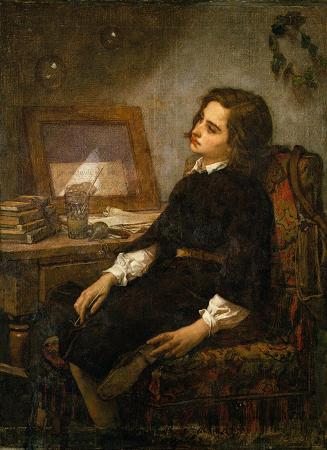
Soap Bubbles. A soap bubble is an extremely thin film of soapy water enclosing air that forms a hollow sphere with an iridescent surface.
Soap bubbles usually last for only a few seconds before bursting, either on their own or on contact with another object. They are often used for children's enjoyment, but they are also used in artistic performances.
Assembling several bubbles results in foam. When light shines onto a bubble it appears to change colour.
Unlike those seen in a rainbow, which arise from differential refraction, the colours seen in a soap bubble arise from interference of light reflecting off the front and back surfaces of the thin soap film. Depending on the thickness of the film, different colours interfere constructively and destructively.
Seman bubbles. Soap bubbles are physical examples of the complex mathematical problem of minimal surface. They will assume the shape of least surface area possible containing a given volume. A true minimal surface is more properly illustrated by a soap film, which has equal pressure on inside as outside, hence is a surface with zero mean curvature. A soap bubble is a closed soap film: due to the difference in outside and inside pressure, it is a surface of constant mean curvature. While it has been known since 1884 that a spherical soap bubble is the least-area way of enclosing a given volume of air, it was not until 2000 that it was prov
Soap bubbles usually last for only a few seconds before bursting, either on their own or on contact with another object. They are often used for children's enjoyment, but they are also used in artistic performances.
Assembling several bubbles results in foam. When light shines onto a bubble it appears to change colour.
Unlike those seen in a rainbow, which arise from differential refraction, the colours seen in a soap bubble arise from interference of light reflecting off the front and back surfaces of the thin soap film. Depending on the thickness of the film, different colours interfere constructively and destructively.
Seman bubbles. Soap bubbles are physical examples of the complex mathematical problem of minimal surface. They will assume the shape of least surface area possible containing a given volume. A true minimal surface is more properly illustrated by a soap film, which has equal pressure on inside as outside, hence is a surface with zero mean curvature. A soap bubble is a closed soap film: due to the difference in outside and inside pressure, it is a surface of constant mean curvature. While it has been known since 1884 that a spherical soap bubble is the least-area way of enclosing a given volume of air, it was not until 2000 that it was prov
Wikipedia ...